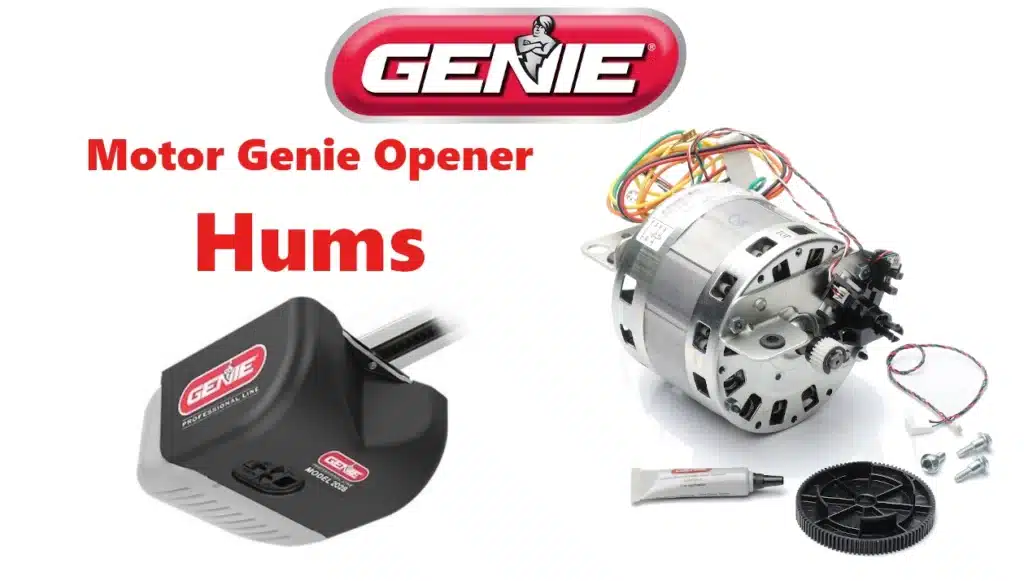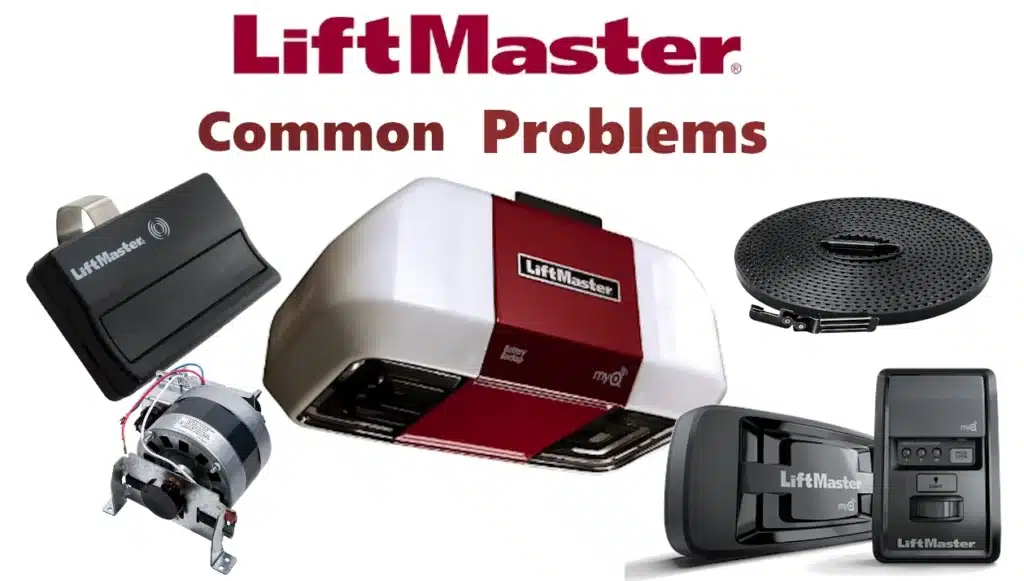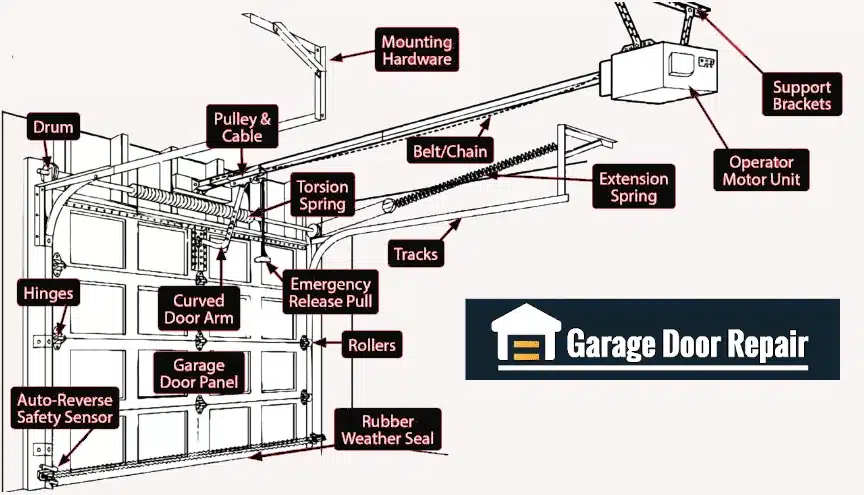Genie garage door openers are generally reliable, but when you press Up or Down and hear the motor humming while the door stays put, it means the opener motor is trying to run against some resistance or disconnect. This buzzing/no-motion symptom usually indicates a problem with the opener’s drive components (motor start capacitor, gears or couplers) or the door’s mechanical connection. For example, a failing start capacitor can cause the motor to hum without turning, and a disengaged trolley or broken spring can make the door too heavy to lift.
Figure: A Genie Excelerator garage door opener (ceiling-mounted). If this opener hums but the door does not move, start by checking the mechanical connections and power.
The solutions range from simple (re-engaging the trolley) to more complex (replacing the capacitor or gear assembly). We’ll walk through the step-by-step troubleshooting and explain the common causes and tests for each. Wherever possible, we’ll cite official Genie guidance or manuals.
1. Check Power, Lock and Sensors First
Before diving into the opener, confirm the basics:
- Power & Remote/Wall Control: Ensure the opener has power (try another outlet or light). Verify the wall switch and remote batteries work. If the opener light or LEDs blink but the door doesn’t move at all, there may be a lockout or power issue (for example, Genie’s “Sure-Lock” vacation mode can disable the opener).
- Manual Lock or Deadbolt: If your door has a sliding manual lock or deadbolt, make sure it’s fully retracted. A locked door can make the opener hum or strain without moving the door. Unlock it and try again.
- Safety Sensors (Photo Eyes): If the safe-beam sensors see an obstruction, the door will refuse to close; however, a blocked sensor typically stops the door (often accompanied by flashing lights) rather than causing a continuous hum. Still, ensure the sensors are clean, aligned, and not causing an immediate reverse.
- Force and Travel Limits (Settings): Sometimes, mis-adjusted limit or force settings can prevent movement. If the opener thinks the door is already at its limit, it won’t try to move it. Consult your Genie manual or use Genie’s “clear limits” procedure to reset the travel limits. For example, on many Genie models you press and hold both limit-set buttons for 10 seconds to clear previous settings, then program the down- and up-limits as instructed. Incorrect limits can make the opener shut off or hum prematurely. Adjust the down-limit so the door rests lightly on the floor (not pressed firmly), then set the up-limit so the door stops just shy of the opener head.
If all basic checks (power on, door unlocked, sensors clear, limits reset) pass and you still only hear humming, proceed with the detailed inspections below.
2. Check if the Door is Disengaged (Trolley/Carriage Disconnected)
A very common cause is that the emergency-release cord was pulled, disconnecting the door from the opener. In this state, the motor will run (and hum) but no motion transfers to the door. Genie explicitly notes: “Your garage door may be disconnected from the opener… If [the release] cord has been pulled, you will need to reengage the carriage”.
How to test: Look at the opener’s trolley (the moving carriage on the rail). If the red release cord is hanging loosely, the door is disengaged. Alternatively, try to open the door by hand: if it moves freely and does not catch the opener, it’s disconnected.
How to fix: Pull the trolley back toward the motor to re-engage it. On most Genies, you simply pull the release cord straight towards the opener to snap the trolley back in place, then manually lift the door a few inches until it catches the opener again. (Some models have a release knob that you twist.) Always follow the instructions in your owner’s manual for reengaging the door. After re-engaging, try the opener again.
Genie guidance: The Genie support site says, “Make sure the carriage is engaged. (Was the emergency release cord pulled? If so, re-engage the carriage.)”. If the carriage isn’t engaged with the chain/belt (or screw), the opener can run but will not move the door.
If re-engaging fixes the problem, you’re done. If not, continue with the steps below.
3. Inspect the Drive Mechanism (Chain/Belt or Screw Drive)
If the carriage is engaged and the door is connected, the next step is to see what the opener is actually doing when you press Up/Down. Carefully remove the motor cover (power off first!) and observe:
3a. Is the Motor Running but the Chain/Belt/Screw Not Moving?
- Chain/Belt drives: If the motor hums and nothing on the rail moves (the chain or belt is not pulling the carriage), check if the opener’s chain/belt has come off its sprocket/pulley or is broken. A twisted, jumped, or broken drive belt can appear stationary while the motor tries to run. Also inspect the belt tension and the pulleys: a broken pully or sprocket can jam the drive. The Genie troubleshooting guide advises: “Check that the carriage is engaged… Check to make sure the chain/belt assembly is not broken or off its pulley. Check to make sure the pulley is not broken.”.
- Solution: If the belt/chain is off, re-seat it on the sprocket. If it’s broken or worn, replace it (you may need a new chain or belt kit). Lubricate the chain lightly if recommended.
- Screw drives: Look at the threaded shaft (screw) running along the rail. If the motor hums and turns on, but the screw does not rotate, the problem is usually the coupler that connects the motor to the screw. Conversely, if the motor hums and the screw does rotate, but the door still doesn’t move, then the carriage (the nut that rides on the screw) is likely stripped or broken.
- Verify: With the door disengaged (release cord pulled), power on the opener briefly. If the screw doesn’t turn at all while the motor hums, the coupler is stripped. If the screw does turn but the motor still hums (and you hear grinding), the carriage teeth inside the opener head are likely stripped.
- Genie advice: “If the screw inside the rail is turning and the carriage is engaged, but the door is not moving – replace the carriage. If the motor is running, but the screw is not turning – replace the coupler.”.
- Solution: For a turning screw with no movement, order the replacement carriage assembly for your model (the plastic nut that engages the screw). For a running motor with a non-turning screw, replace the coupler that joins the motor and screw (this is a common wear item).
Figure: A Genie screw-drive opener head. The motor (left) drives a long threaded rod (right) that moves the door carriage. If the opener hums and the threaded rod spins but the door doesn’t move, the carriage nut may be stripped and needs replacement.
3b. Grinding or Loose Parts
Also listen for unusual noises: grinding, clicking, or clunking can indicate broken gears or hardware. On screw drives, plastic gears or bronze worm gears can break; on chain drives, a stripped sprocket or worn motor gear can cause slipping. If you see metal shavings or broken plastic pieces inside the genie opener, that part is damaged. The Overhead Door troubleshooting guide (Chamberlain brand) even notes for a humming motor: “Check the starting capacitor… Check to see if [the] main drive gear is cracked”. In any case, any shattered components must be replaced (often a motor gear kit or entire motor head). For reference, consult the genie garage door opener parts list to identify compatible replacement components and ensure proper repair.
4. Test the Start Capacitor and Motor
A very common electrical cause is a faulty start capacitor. Genies use an AC motor that needs a capacitor to spin up. When the capacitor goes bad, the motor will just hum. Signs include humming, very slow rotation, or no rotation. In fact, if your opener used to work intermittently or start sluggishly, then failed to move but still hummed, a weak capacitor is prime suspect.
How to identify: With power off, open the motor housing and locate the cylindrical capacitor (often 50–70 µF). Inspect it visually: a swollen or leaking capacitor is bad. Even if it looks normal, you can discharge it (short its terminals carefully with an insulated tool) and then measure it with a multimeter set to capacitance or resistance. A healthy capacitor should show rising resistance (or proper µF value). If it reads open or shorted, replace it.
Testing tip: Disconnect the motor or carriage from the door (pull the release cord) and try running the opener. If the motor still only hums with no load, the motor/capacitor is at fault. The JustAnswer troubleshooting summary notes that “a buzzing sound without motor movement usually indicates a faulty start capacitor or motor winding issue”.
Solution: Replace the capacitor with the correct value for your opener (Genie 50µF or 70µF, depending on model). Genie sells OEM capacitors (70MFD part 37954R.S, for example). For safety, make sure power is off and capacitor is discharged before swapping it. After replacement, restore power and test: the opener should now turn smoothly if the capacitor was the culprit.
If a new capacitor doesn’t fix it, the motor windings or circuit board might be at fault. A failed motor will still hum but rarely short out. At that point it’s often more practical to replace the entire unit or call tech support.
5. Check Door Springs and Balance
If the opener gear and motor are fine, the door itself might be too hard to lift. Genie notes broken springs and excessive door binding can cause the opener to strain. Try this simple but crucial test: disconnect the opener (pull release) and lift the door by hand. A properly balanced door should lift easily and stay open about halfway on its own spring tension. If the door feels very heavy (more than ~20 pounds) or drops closed, the springs are weak or broken.
In fact, garages door experts say: “If [the door] feels heavier than 10–20 pounds or is difficult to push overhead, you likely have a broken or improperly tensioned spring.”. Without strong springs, the opener simply can’t lift the weight, causing the motor to hum and stall.
Solution: Do NOT attempt to wind or replace torsion springs yourself unless you have proper tools and training – broken springs can be dangerous. Call a qualified technician to replace or re-tension the springs. Once the springs are fixed, the door should lift easily and the opener will again be able to move it.
6. Adjust Limit and Force Settings
A mis-set travel limit or force control can sometimes make it seem like the opener won’t move. If the motor hums only briefly and then stops, the opener may think it hit a limit or obstruction. Check the limit dials or digital settings on the motor head. Genie’s limit troubleshooting says you can clear and reset the limits by using the “Set” buttons: press both the up- and down- set buttons for 10 seconds, then program the limits anew. This ensures the opener knows where fully open and fully closed are.
Also check the Force Adjustment (often two small dials). If the force is set too low, the opener will cut power as soon as it encounters any resistance (even normal door weight). Try increasing the force slightly so the opener can move the door. If your door still tries to reverse quickly, it likely needed higher force or has an obstruction as described in [23].
7. Step-by-Step Troubleshooting Checklist
To summarize, here’s a practical checklist of what to do when your Genie opener hums with no motion:
- Power & Lock Check: Verify power and that the door isn’t manually locked. Test wall switch vs. remote.
- Emergency Release & Manual Test: Pull the red release cord and manually open the door. If it’s very heavy or won’t budge, suspect broken springs. If it moves easily by hand, re-engage the trolley (push the release cord forward).
- Observe Mechanism: Reconnect power and run the opener. Watch the chain/belt or screw: does anything move?
- If nothing moves at all, double-check carriage engagement or chain derailing. Ensure the chain/belt is on the sprocket.
- If chain/belt moves but door still doesn’t, follow the chain to see if it slips or the door arm has popped loose.
- If screw rotates but door not moving, the carriage is stripped – plan to replace it.
- If motor spins with a hum but screw doesn’t turn, replace the drive coupler.
- Listen for Noises: Grinding or clicking inside the opener suggests broken gears. A crunchy sound usually means a stripped plastic gear in the motor head. Replace the gear kit (available from Genie).
- Test Capacitor: With power off, disconnect motor from door and temporarily run it. If it still only hums, discharge and remove the capacitor for testing. Swap in a known-good capacitor and try again.
- Check Settings: Reset the up/down limits using the Genie procedure. Increase the force (down-limit) adjustment slightly if the door won’t move under load.
- Inspect Springs: Pull the release cord again and lift the door. If the door stays open or is very easy, springs are probably okay. If it falls or is very heavy, arrange spring service.
Proceed methodically: check carriage engagement, drive mechanism, then electrical components, then spring/balance. Use Genie’s troubleshooting page as a guide. For example, the Genie support page clearly divides actions by model type: “Opener runs but door does not move (chain/belt): Make sure the carriage is engaged… chain not broken/off pulley… Replace broken chain or pulley”. For screw models it advises: “If screw is turning and carriage engaged but door not moving – replace the carriage. If motor is running but screw not turning – replace the coupler”.
8. When to Call a Professional
Some fixes are straightforward DIY, but others require professional help. Call a Genie dealer or qualified technician if:
- Broken springs: Garage door springs are under high tension and can cause injury. Spring replacement is usually best left to pros.
- Major gear or motor failure: If the motor windings or main gearbox are burned out (i.e. you replaced the capacitor and belt/coupler and it still hums), it may be cheaper to replace the opener than repair internal parts.
- Persistent issues after troubleshooting: If you’ve run through the checks above and the door still won’t budge, a tech can do further diagnostics (checking circuit boards, wiring, etc.).
- No time or comfort: If you’re not comfortable working inside the opener motor or on ladder, hire help. Even if it’s something simple, it’s better done safely by a pro than risking damage or injury.
Many Genie issues can be fixed at home, but Genie’s own support suggests contacting them or a dealer if basic troubleshooting doesn’t resolve the issue. In particular, always prioritize safety: a humming motor under heavy load can overheat, and a badly overloaded opener or broken spring can pose danger.
9. Summary
In short, a humming Genie opener with no door movement means power is reaching the motor but something is blocking motion. The most common causes are a disengaged trolley, a failed start capacitor, a stripped drive component, or excessive door resistance (springs). Follow these steps:
- Ensure the door is connected: Re-engage the trolley if the red cord was pulled.
- Inspect the drive: Check if the chain/belt/screw is turning. Replace the carriage or coupler if needed.
- Test the capacitor: Swap in a new start capacitor if the motor only hums.
- Check springs/balance: Verify the door lifts easily by hand; arrange spring repair if it feels heavy.
- Adjust settings: Reset limit switches and adjust force limits using Genie’s procedures.
By systematically checking each possible fault — and referencing Genie’s official troubleshooting tips — most homeowners can diagnose the issue. And remember: if at any step something looks unsafe or too complex, call a qualified garage door technician.



